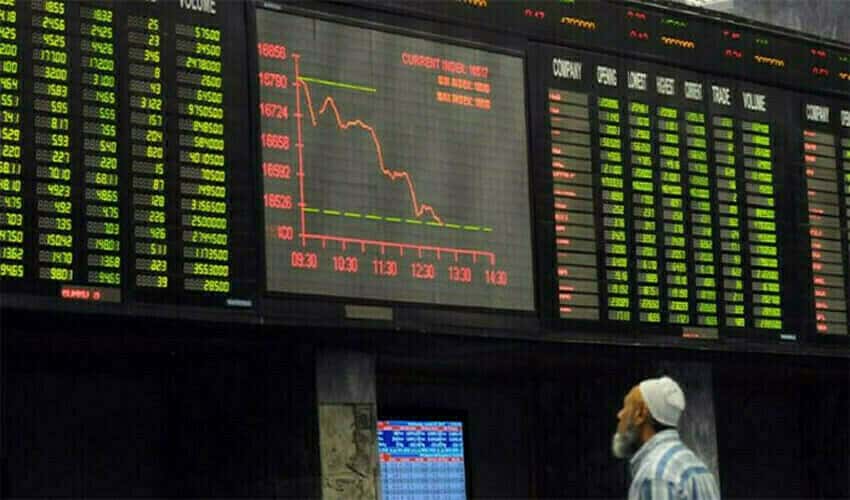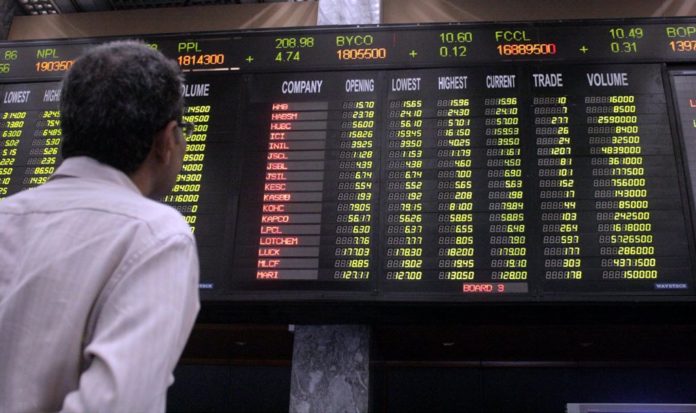PTBP Web Desk
The Pakistan Stock Exchange (PSX) experienced a volatile trading session on Wednesday, as the benchmark KSE-100 Index fell sharply by nearly 800 points. After showing resilience in the early hours, the market came under intense selling pressure in late trading, largely due to profit-taking by investors who sought to secure recent gains amid rising global uncertainty.
At the end of the session, the KSE-100 Index closed at 166,553.27 points, reflecting a decline of 793.56 points or 0.47%. During the day, the index touched an intra-day low of 166,230.89, as selling accelerated in energy, technology, and banking sectors.
The downturn followed two consecutive days of gains, with the KSE-100 Index having climbed 1,103.93 points (0.66%) on Tuesday to close at 167,346.83 points. The prior sessions were buoyed by positive investor sentiment stemming from a ceasefire agreement between Pakistan and Afghanistan, which eased regional tensions and encouraged short-term optimism in the equity market.
However, as analysts had warned, the market appeared overbought, and investors opted to book profits before fresh catalysts could emerge. The late-session selling wiped out much of the week’s earlier momentum, suggesting a cautious outlook among traders.
Market observers attributed Wednesday’s losses to profit-taking pressure after a strong rally earlier in the week. According to analysts, the trading pattern remained range-bound for most of the session before heavy selling dragged down key stocks in the final hours.
Institutional investors and mutual funds appeared to offload positions in high-value sectors such as banking, oil & gas, and cement, reflecting both valuation concerns and global market headwinds.
Despite the pullback, several analysts noted that the market’s underlying fundamentals remain stable. “Profit-taking after a strong two-day rally is healthy, especially given the global risk-off sentiment,” one brokerage analyst said.
The PSX’s decline coincided with a downturn in global stock markets, as investors worldwide reassessed their portfolios amid concerns about economic slowdown, geopolitical tensions, and overstretched valuations.
Across Asia, the MSCI Asia-Pacific Index (excluding Japan) dropped 0.24%, while Nasdaq futures slipped 0.2%, and S&P 500 futures dipped 0.07% following a mixed session on Wall Street.
In Europe, EUROSTOXX 50 futures were down 0.5%, FTSE futures eased 0.15%, and DAX futures declined 0.26%, signaling a cautious global trading environment.
Meanwhile, gold prices retreated sharply after a powerful rally earlier in the week. The precious metal has been one of the year’s top-performing assets, surging over 50% due to growing geopolitical uncertainty and expectations of U.S. interest rate cuts.
However, analysts said that the latest correction was expected as investors booked profits amid changing sentiment. The pullback in gold reflected a temporary shift away from safe-haven assets, as some investors sought liquidity in equity markets.
Global geopolitics continued to play a central role in shaping investor sentiment. Reports indicated that a planned summit between U.S. President Donald Trump and Russian President Vladimir Putin had been put on hold, adding to the uncertainty surrounding diplomatic relations.
Additionally, ambiguity persisted over a possible meeting between Trump and Chinese President Xi Jinping, casting doubt on progress in global trade discussions. The lack of clarity over these high-level engagements contributed to cautious trading across international markets.
In the United States, corporate earnings results also added to market fluctuations. Netflix shares plunged nearly 6% after the streaming giant missed its third-quarter earnings targets, disappointing investors who had expected stronger subscriber growth.
In contrast, General Motors (GM) stock surged 15% after the automaker raised its annual profit forecast, citing improved production efficiency and demand resilience. These contrasting performances contributed to the mixed tone in U.S. equity markets, which spilled over into regional trading sentiment, including emerging markets like Pakistan.
Despite the day’s decline, analysts remain cautiously optimistic about the medium-term outlook for the Pakistan Stock Exchange. They point to improving macroeconomic indicators, lower inflation, and a stable rupee as factors that could support renewed market confidence.
However, profit-taking, political uncertainty, and global economic risks are expected to cause short-term volatility. Investors are advised to adopt a selective approach, focusing on fundamentally strong sectors such as banking, fertilizers, and technology, which are better positioned to weather external shocks.
“The market’s pullback should be seen as a cooling-off phase rather than a reversal,” one analyst told Business Recorder. “The fundamentals remain intact, and any correction could provide an entry opportunity for long-term investors.”




